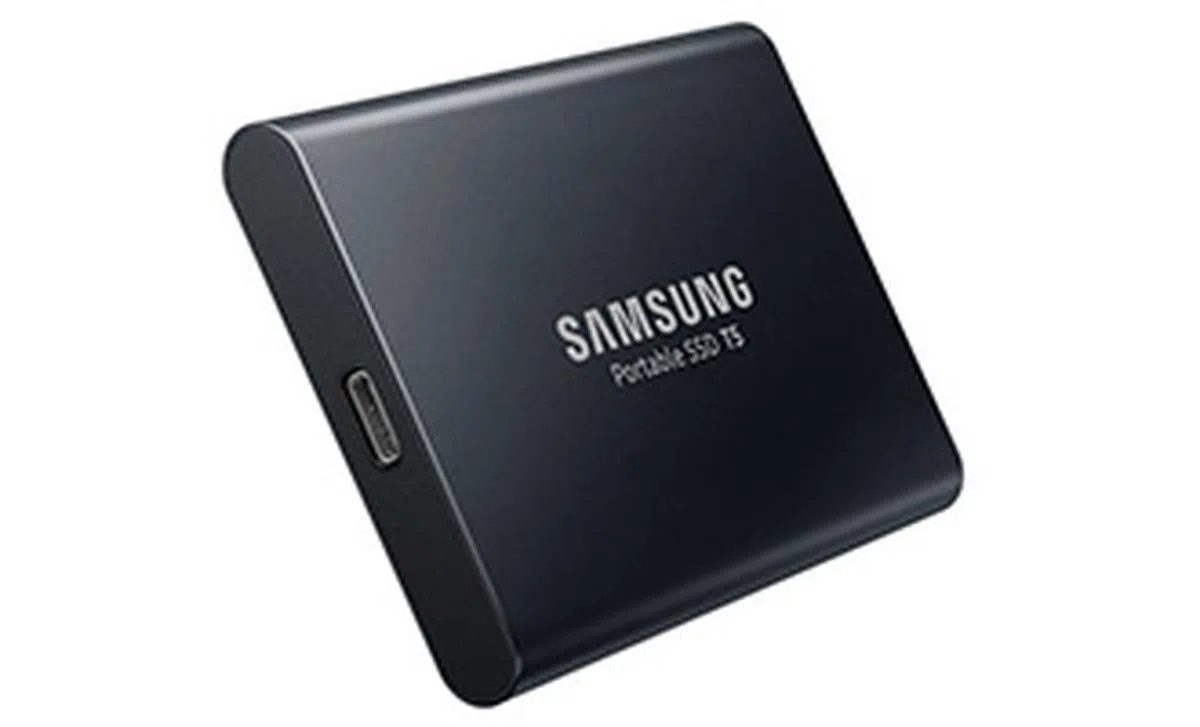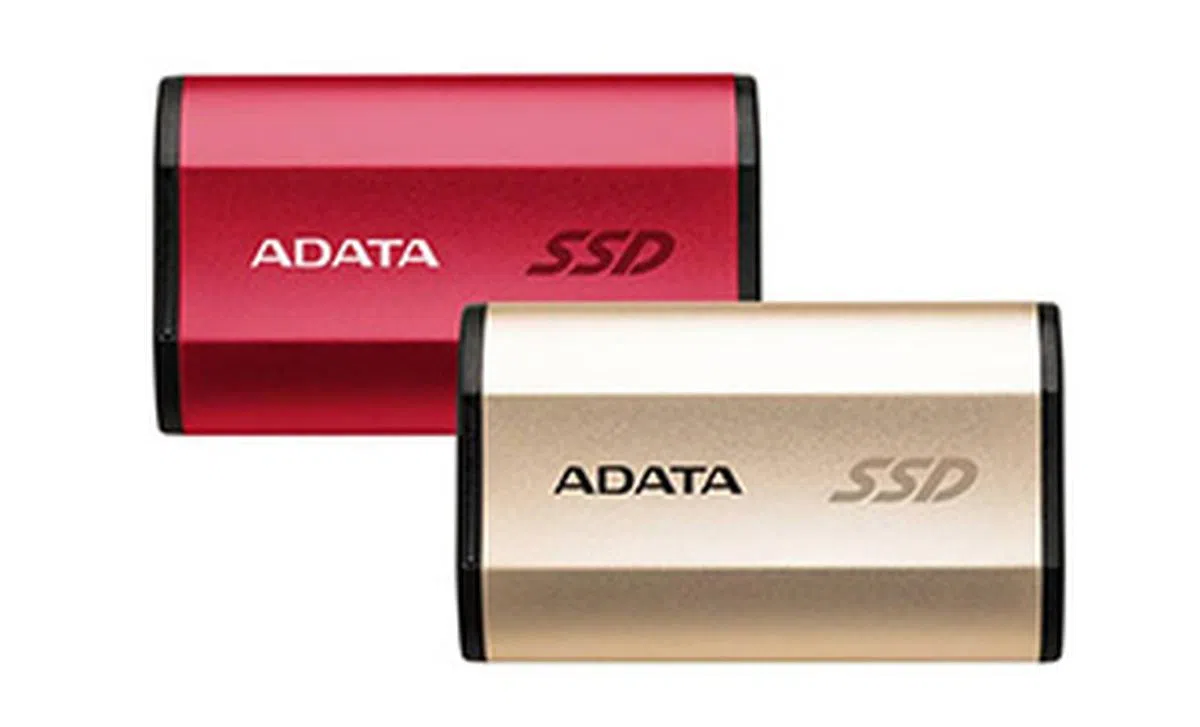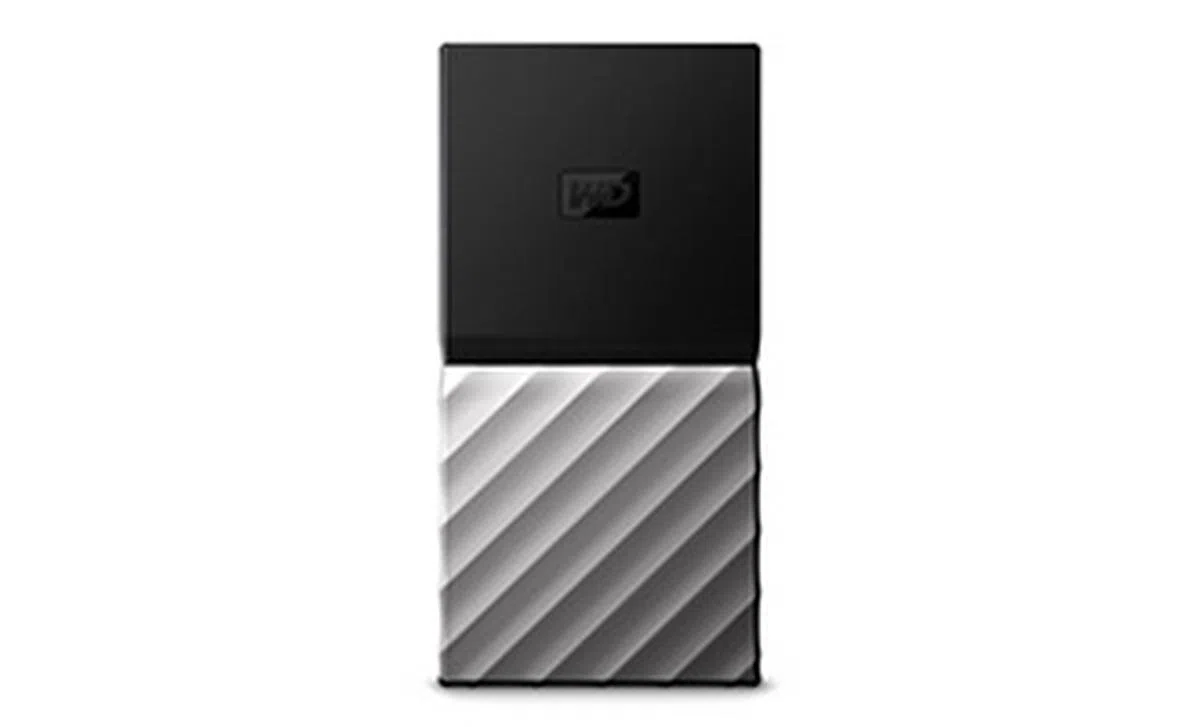Note: This article was first published on 24th January 2018.
Why consider a portable external SSD?
SSDs are slowly but surely displacing traditional HDDs in the client computing space. There are a number of good reasons why. As we all know, SSDs are many, many times faster than HDDs. Even the most basic SSD will run rings around the fastest HDD. And because they have no moving parts, they are much more resistant to shock than HDDs, which makes them ideal for use in mobile and portable devices. Finally, SSD prices have been gradually falling over the past couple of years and are now affordable enough to be adapted for mainstream adoption. As a result, portable external SSDs are becoming an increasingly popular accessory for users who demand performance even from their portable storage devices.
Obviously, most users will be able to get by fine with a typical portable external HDD, but a portable external SSD has some benefits. If you use a portable storage drive for backing up, a portable external SSD is going to save you a lot of time because of its significantly faster data transfer rates. This not only reduces backup times, it also means that if you do need to restore your system from your backup you can do it much quicker.
Likewise, if you have to transfer and share large amounts of data and files often, a portable external SSD can save you a lot of time. In our past tests, we found that a portable external SSD will take less than half the amount of time to transfer 16GB of data as compared to a portable external HDD. Imagine the amount of time you could save if you had to do this multiple times a day, and with greater data sizes.
Finally, portable external SSDs are also great if you intend to run another operating system on your device but don’t necessarily want to take up precious space on your primary drive. Of course, you could do this on a portable external HDD, but it will be woefully slow. A portable external SSD will speed things up a lot.
The ADATA SE730H

The ADATA SE730H is supremely compact.
ADATA has been one of the most aggressive players in the portable external SSD market. In total, ADATA has a portable external SSD lineup consisting of no less than 8 drives in different form factors and utilizing different types of flash memory. Its flagship is the SE730H. And on paper, it looks like a keen contender.
ADATA claims that the SE730H is the world’s most compact SSD and it is slightly less bulky than its rivals. In addition, ADATA is also proud of the fact that the SE730H is IP68 dust and water resistant, and that it has passed the U.S. Army MIL-STD-810G 516.6 shock and drop resistance test. In short, the SE730H is one tough and sturdy drive and should hold up well to the rigors of daily use.

A safety cap help ensures dust and water resistance. When in place, the SE730H can stay submerged in 1.5 meters of water for up to 30 minutes.
The reason the SE730H is so tough is due to its design. It features an aluminum chassis that feels extremely solid and exhibits no flexing even under heavy pressure. To spice things up a little, it is available in red and gold finishes. Also, the SE730H is water resistant because its connector is hidden behind a plastic and rubber cap. The cap secures tightly to the case and quite a fair amount of force is required to pop it open. This ensures water does not get into the connector and drive. Pop it open and you will be greeted by a USB Type-C connector. ADATA also clearly states that the SE730H’s dust and water resistant ratings only apply when the cover is firmly sealed.
The SE730H supports USB 3.1 (Gen 2) and that means speeds of up to 10Gbps - an upgrade from the ADATA SD700 that we tested last year. Inside the drive, what you will actually find is a compact M.2 2242 SSD drive with a Silicon Motion SM2258 controller and 3D TLC NAND from Micron. USB bridging duties are handled by a VIA Labs VL716 chip. And according to ADATA, users can expect transfer speeds in the region of around 500MB/s. The SE730H is only available in 256GB and 512GB capacity points.

On the back of the drive are regulatory markings. Proudly made in Taiwan.
Unlike its rivals, the SE730H drive only comes with a USB Type-C to USB Type-C cable and that’s it. There are no additional cables and there are no bundled security or backup software. Users will have to take measures of their own to prevent unauthorized access to their data.
Samsung Portable SSD T5

The Samsung Portable SSD T5 looks almost identical to its forebears.
The Samsung Portable SSD T5 is the flash memory giant’s third generation portable external SSD. It is the successor to the Portable SSD T1 and the Portable SSD T3.
In terms of design and size, the new Samsung Portable SSD T5 is identical to the T3. It is very small, about the size of a typical name card and weighs just slightly over 50g. The Portable SSD T5 features an all-aluminum chassis to help dissipate heat and comes in blue and black finishes. The Portable SSD T5 is available in 250GB, 500GB, 1TB, and 2TB capacity points - identical to the T3. The smaller 250GB and 500GB models come in blue, while the larger 1TB and 2TB models come in black.

The Samsung Portable SSD T5 uses a USB Type-C connector and supports the faster USB 3.1 (Gen 2) standard.
The big change is on the inside. The Portable SSD T5 uses Samsung’s latest 64-layer TLC V-NAND. Back in June, Samsung announced that they would be ramping up production of this particular memory and the T5 is the first consumer product to use it. The Portable SSD T5 also uses an upgraded ASMedia bridging chip, thereby allowing the T5 to support USB 3.1 Gen 2 speeds of up to 10Gbps. The Portable SSD T5 uses a USB Type-C connector. Completing the package is Samsung’s MGX controller, the same used in the very excellent SSD 850 Evo. According to Samsung, the Portable SSD T5 will support transfer speeds of up to 540MB/s.
The Samsung Portable SSD T5 comes with extra accessories and software. Users will be happy to know that Samsung has thoughtfully provided two cables with the Portable SSD T5: a USB Type-C to USB Type-C cable and USB Type-C to USB Type-A cable. This means users will be able to use the Portable SSD T5 with their devices even if it doesn’t have a USB Type-C port.

The Portable SSD T5 comes with a simple but effective password protect feature.
On the software side, the Samsung Portable SSD T5 comes bundled with the Samsung Portable SSD security software. This allows users to enable “Security Mode”, which is basically a password protect feature for the T5 that enables 256-bit AES encryption. This is disabled by default, but users can activate it by entering a password of their choice. A word of warning, however, there is no way to reset the drive if you forget your password. If you do forget your password, the only fix is to bring to Samsung and have them factory reset it for you, but doing so means you lose all your data.
WD My Passport SSD

The WD My Passport SSD might be the largest, but it is still about the size of a typical name card.
After acquiring SanDisk, WD wasted no time in releasing a string of SSD products. The My Passport SSD is its first portable external SSD and, on paper, it sounds like a keen contender.
It is the largest of the trio, but not by a whole lot. It is roughly the size of large Zippo lighter so it will still fit easily into your pockets. It is also the second lightest drive here at just 40g. However, unlike the ADATA SE730H and Samsung Portable SSD T5, the My Passport SSD has a plastic chassis. Even so, it doesn’t detract from its performance. In fact, WD says the My Passport SSD is built to withstand drops of up to 1.98 meters. In addition, I would argue that the My Passport SSD looks the most interesting of the trio. The alternate finishing on the chassis is quite attractive and certainly more interesting than the SE730H or T5.

USB Type-C is the interface of choice for fast portable external SSDs.
Like its competitors, the My Passport SSD relies on a USB Type-C connector and supports USB 3.1 Gen 2 speeds of up to 10Gbps. To ensure maximum compatibility, the My Passport SSD also comes with a handy USB Type-C to USB Type-A adapter so that you can use it with devices that do not have USB Type-C ports. Unsurprisingly, if you peel open the chassis, what you will find inside is an M.2 SATA drive that is based on the SanDisk X400 SSD. This means a Marvell 88SS1074 controller paired with SanDisk TLC NAND. WD claims data transfer rates of up to 515MB/s. The My Passport SSD is available in 256GB, 512GB, and 1TB capacities.
Similar to the Samsung T5, the My Passport SSD comes with WD Discovery, a suite of backup and drive utilities. The most important of them all is probably WD Drive Lock, which lets users password protect their drive. It uses hardware 256-bit AES encryption. Another useful utility is WD Backup, which is a backup utility that lets user back up their system to the drive or to a Dropbox account.

You can password protect your My Passport SSD to prevent unauthorized access.
Based on first impressions, it seems like the My Passport SSD treads a middle ground between the ADATA SE730H and Samsung Portable SSD T5. Its claimed performance isn’t quite as fast as the Portable SSD T5, but it should be more rugged since it is rated to be able to survive drops of up to 1.98 meters. On the other hand, the My Passport SSD can’t match the SE730H in the ruggedness stakes as the latter has IP68 rating for dust and water resistance.
Test Setup
The drives will be tested on our updated storage testbed using the Windows 10 operating system, which has the following specifications:
- Intel Core i7-4770K (3.5GHz)
- ASUS Z97-Deluxe/USB 3.1 (Intel Z97 chipset)
- 2 x 4GB DDR3-1600 memory
- MSI GeForce 8600 GTS
- Windows 10 Pro
We have also revised our benchmarks and the list used are as follows:
- AS-SSD benchmark 1.8.5636.36856
- CrystalDiskMark 5.0.2
- PCMark 8 (Storage suite)
We will be testing the maximum capacities of the drive and we will be including results of the ADATA SD700 and Samsung T3 to see how much improvement these trio of portable external SSDs, with their support for the faster USB 3.1 Gen 2 interface, will yield.
PCMark 8
The Samsung Portable SSD T5 came out tops in PCMark 8 with a score of 4972. That’s only marginally more than the other drives, but if you look at the average speeds recorded, you’ll see that the T5 is significantly quicker. In terms of average speeds, the Samsung Portable SSD T5 came in at 255.71MB/s - that’s 24% faster than the ADATA SE730H and a whopping 232% faster than the WD My Passport SSD. Also, despite supporting “only” the slower USB 3.1 Gen 1 standard, the older ADATA SD700's and Samsung T3’s numbers were still very respectable.



Timing Test
In this test, we timed how long it took for the drive to copy a folder of 16GB worth of movies, music, and photos. The ADATA SE730H came up tops with a time of 57 seconds and the Samsung Portable SSD T5 followed closely behind with a time of 60 seconds, which was about 5% slower. Finally, the WD My Passport Port SSD recorded a time of 66 seconds, which was about 10% slower than both the ADATA and Samsung drives.

AS SSD Results
AS SSD is a benchmark that uses non-compressible and completely random data. This takes away the advantages of SSD controllers that compress data before moving them, such as the old SandForce SF-2281 controller.
AS SSD’s Copy Benchmark measures the performance of copying various types of data and the results here were quite close. However, the ADATA SE730H has a slight edge since its performance on the Program and Game workloads were quite impressive.
Moving on, the Samsung Portable SSD T5 was the runaway leader posting impressive read and write speeds across all different workloads. The ADATA SE730H’s sequential read and write performance was quite comparable, but it couldn’t keep up when it came to workloads with smaller data blocks and higher queue depths. The WD My Passport SSD performance was quite disappointing. Its sequential write speeds were significantly lower than the Samsung and ADATA drives. More importantly, its performance on the intensive 4K, 64 threads workloads was very much poorer than any other drive.




CrystalDiskMark Results
CrystalDiskMark is an easy-to-run and quick utility to use to gauge a drive’s performance. It measures sequential read and write performance and random read and write speeds of random 4KB, 4KB (queue depth 32) and 512KB data.
On CrystalDiskMark’s sequential read and write test, the trio of drives posted very comparable numbers. They were also noticeably faster than the ADATA SD700 and Samsung T3, which demonstrates the benefits of the faster USB 3.1 Gen 2 connection.
When it came to smaller 4K data blocks, the Samsung Portable SSD T5 pulled ahead with the highest read and write speeds. The ADATA SE730H was close behind. However, the WD My Passport SSD was significantly slower - its write speeds were significantly slower.
On the demanding 4K, 32 queue depth workload, the Samsung Portable SSD T5’s read speeds were amazing. It recorded 335.8MB/s, which is a staggering 300% faster than the ADATA SE730H and over 12 times faster than the WD My Passport SSD. Clearly, the My Passport SSD is significantly poorer when it comes to handling smaller data blocks and high queue depths.



And the best portable external SSD is...
Prices of portable external SSDs have fallen quite dramatically, especially for the smaller 250/256GB and 500/512GB capacity drives. Last year, a 250GB and 500GB Samsung Portable SSD T3 would have cost you S$269 and S$329 respectively. Now, a Samsung Portable SSD T5 with similar capacities would set you back S$179 and S$279 respectively - that’s considerable savings. As a result, portable external SSDs today are a lot more compelling especially to users who demand a speedy portable external storage drive.
For readers who demand a tough drive that can stand up to dust and water, the ADATA SE730H is the obvious choice. It is the only drive here that is rated IP68 dust and water resistant. Plus, its aluminum casing feels solid too. Obviously, not everyone is going to be subjecting their portable external SSDs to dust and water, but its good to know that if the situation calls for it (say you are caught in the rain), the drive will do just fine.

There are no losers here, but we feel that the Samsung Portable SSD T5's blend of performance, design, and usability makes it the best drive for most people.
For everyone else, the Samsung Portable SSD T5 is the better option simply because it is super compact and super fast. It also comes with two cables so that it works with just about any device and it comes with an easy to use app that secures your drive. Even though it's slightly pricier than its rivals, these attributes make it the ideal portable external SSD for most consumers.
The WD My Passport is a fine portable external SSD and a commendable first showing from WD. However, it suffers from some pretty significant performance issues especially with regards to its performance with high queue depth operations. This can have a negative impact on certain workloads, especially if backup frequently to the drive or intend to run programs off it. On the flip side, the WD My Passport SSD is one of the more affordable options.
ADATA SE730H | Samsung Portable SSD T5 | WD My Passport SSD | |
Design | 8.5 | 8.5 | 8.0 |
Performance | 8.5 | 9.0 | 7.0
(revised downward from 8.5 in earlier evaluation) |
Features | 8.0 | 8.0 | 8.5 |
Value | 8.0 | 7.5 | 8.0 |
Overall | 8.0 | 8.5 | 7.5
(revised down from 8.5) |
Price |
|
|
|
 | |
 | |
 |
Our articles may contain affiliate links. If you buy through these links, we may earn a small commission.


